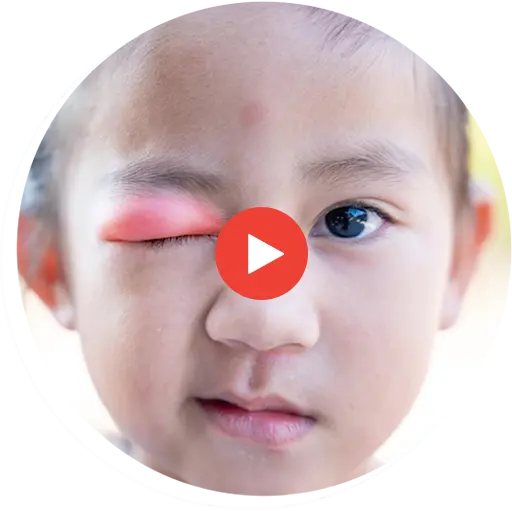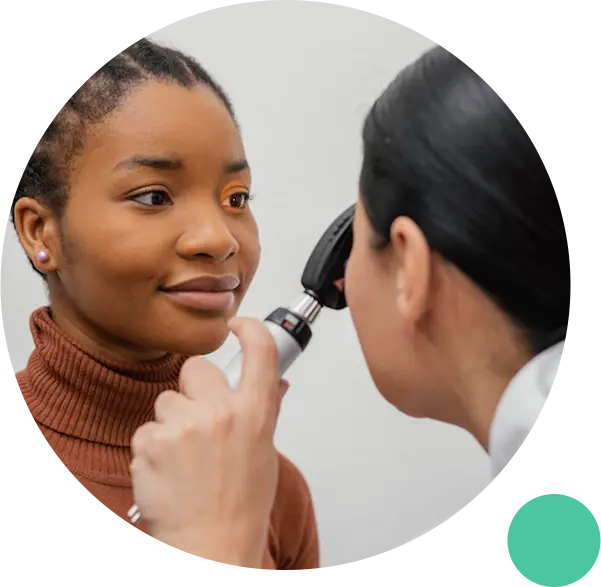

TELMDCARE
What is Stye?
A stye is a common name for an itchy, crusty, or pus-filled bump that can form on the eyelids and near the corners of the eyes. This is typically caused by bacterial infection of the oil gland at the opening of the eyelid. This bacterial infection can cause damage to the top layer of skin (epidermis) and even spread from one eye to the other.
People typically get styes from dirty hands or contact lenses. They may also develop it if they have colds or other infections that affect their eyes.
Although styes are common and easily treatable, it may be necessary for your online doctor for the stye to prescribe medication for a short time if they become chronic or recur frequently. If left untreated, styes can cause severe inflammation and damage your eyes.
TELMDCARE
Is covered by many popular
insurance plans

TELMDCARE
Symptoms of Stye infection
Styes can cause a variety of symptoms.
A stye is usually a painful red bump that develops in the eyelid or on the eyelash area. It may also be swollen and feel warm to the touch. Sometimes, it may cause minor discomfort and tenderness when you press on it. If you have an active stye, it will hurt when touched.
- Bleeding from the affected part
- Painful itchiness and burning sensation around the affected area (itching typically starts 2-3 days after infection)
- Redness in the affected area
- A lump under the skin near your tear duct
- Tiny blood vessels that are visible through the skin (papillae)
What Causes A Stye Infection?
- Glue-like discharge or crusts around the eye
- Frequent blinking and rubbing around the eye. This may be due to dry eye
- Sores and boils in the area where it hurts most, such as under your lower eyelid, near your nose, or between your eyebrows
Bacterial Infection
Styes are caused by the bacteria Corynebacterium (pneumonia) or Streptococcus pyogenes. This bacteria is commonly found in soil and dust. Styes are not contagious but can be painful and may sometimes lead to scarring or permanent damage to the eyelid.
Fungal Infection (Candida albicans)
This yeast is found in the air and on surfaces around us. Candida albicans can enter wounds through cuts or scrapes in healthy skin because it’s very common for people with normal skin to carry yeast cells around inside them.
The following factors increase your risk of developing a fungal eye infection:
- Having a weakened immune system as often happens in people with diabetes or HIV/AIDS.
- Being on systemic corticosteroid medication or having had a recent eye operation.
- Having been exposed to strong sunlight (e.g., long hours in the sun).
Allergic reaction
Injury to the eyelid
The Condition
Age
Skin type
People with dry skin and a tendency to develop ingrown hairs may be at higher risk of developing styes because their skin is flaky and irritated by everyday activities like shaving or washing their face.
Those with oily skin are also at higher risk because their pores are larger and, therefore, more likely to become clogged with dirt and oil particles that irritate the skin when they get wet from sweat or water exposure (such as swimming).
History of eye infections
Hormonal changes
Poor hygiene practices

TELMDCARE
As Seen On


TELMEDCARE
What we treat
We treat a variety of acute and chronic conditions and provide expert medical advice and guidance for our patients.
TELMDCARE
About Stye
Styes are small, red bumps that are often found on the upper eyelid. Styes usually appear when dirt or a foreign particle gets trapped under the skin and irritates it. The irritation leads to swelling, which makes it harder for the skin to heal itself, and the bump can become infected if it stays there for too long.
There are different types of styes—some are caused by bacteria, others by fungi—but all of them can cause pain and discomfort when they’re present in your eye area. If you have a stye infection in your eye, you may have difficulty seeing clearly. You may also notice that the infected area looks slightly darker than normal skin around it—this is called “vesiculitis” or “inflammatory vesicles.”
You should see an eye doctor as soon as possible if you suspect a stye infection because this condition can be treated with antibiotics if caught early enough and treated properly.


Medication services available 24/7 for adults and kids (3+)

Top quality, board-certified doctors

No insurance needed

Same-day prescriptions available*
*Prescriptions provided at doctor’s discretion.
TELMDCARE
When To Consult An Online Doctor For Stye
A stye is a painful, itchy inflammation of the eyelid. These are usually red and swollen, but they may also itch or burn when they’re first forming.
If you develop a stye that lasts longer than five days, you should seek medical attention right away. Our online doctor for stye will examine your eyes and prescribe antibiotics to prevent infection. You should also make sure to avoid rubbing the stye once it starts to clear up or keep it covered with antibiotic ointment until the redness goes away.
Treatment Options For Stye
Laser treatment

Antibiotics
Topical creams
Topical corticosteroid ointments are generally used to treat mild cases of styes. These medications reduce the size and number of affected follicles. They also help prevent further damage to your eyelash or eyelid.
To help prevent infections of your eyelashes or eyelids, your online doctor for stye may suggest using antibiotic eye drops to treat the infection.
If your symptoms don’t improve with topical medication, get online stye treatment from our highly qualified virtual doctors for stye at TelMDCare.

Get Affordable Online Stye Treatment
At TelMDCare Today
TelMDCare is a leading online healthcare platform that provides affordable healthcare services, including online stye treatment to its patients. The company also provides other healthcare services like joint pain relief, along with treatment for hair loss, conjunctivitis, pink eye, sexually transmitted diseases, and other acute and chronic skin infections.
Our reviews section is a treasure trove of useful medical information and an online consultation option for patients to seek medical advice from our online doctors.
The clinic has a team of highly qualified professionals who are well-equipped with modern technology and the latest equipment. So, for just $43, you may now register to make an appointment with our general physician, who will give you a formal diagnosis and write you a prescription. We also provide online chat alternatives and free follow-up services without any wait time.
Join now and let our online doctors for stye assist you in leading a more comfortable, pain-free, and healthy life.
TELMDCARE
Sign Up
Our best online doctors on call ensure that the services we provide are adequate, high quality, and affordable.
Get in touch with us today for more details or Sign Up for a quick consultation.
TELMDCARE
FAQs For Stye
How do I get a stye?
How Do I Prevent Stye Infection?
- Wash your hands with soap and water before you touch your face or rub your eyes.
- Don’t share make-up, towels, razors, toothbrushes, and other personal items with family members or friends.
- Wear sunglasses if you must wear make-up or a lot of eye shadow.
- Avoid contact lenses if you have diabetes or a weakened immune system. And don’t wear them for too long if you don’t have these conditions
- Similarly, a recurrent stye can be prevented by avoiding tight-fitting headgear, hats, and wigs since tightly fitting headgear may cause a pressure sore to develop.



